
Captain James Cook was a British explorer, cartographer and naval officer famous for his three voyages between 1768 and 1779 in the Pacific Ocean and to New Zealand and Australia in particular. He made detailed maps of Newfoundland prior to making three voyages to the Pacific, during which he achieved the first recorded European contact with the eastern coastline of Australia and the Hawaiian Islands, and the first recorded circumnavigation of New Zealand.
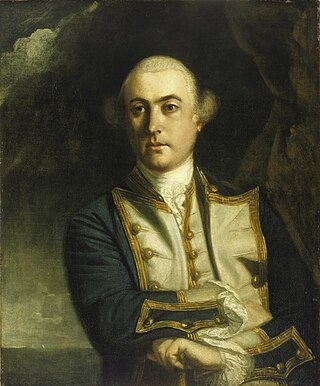
Vice-Admiral John Byron was a British Royal Navy officer and explorer. He earned the nickname "Foul-Weather Jack" in the press because of his frequent encounters with bad weather at sea. As a midshipman, he sailed in the squadron under George Anson on his voyage around the world, though Byron's ship, HMS Wager, made it only to southern Chile, where it was wrecked. He returned to England with the captain of the ship. He was governor of Newfoundland following Hugh Palliser, who left in 1768. He circumnavigated the world as a commodore with his own squadron in 1764–1766. He fought in battles in the Seven Years' War and the American Revolution. He rose to Vice Admiral of the White before his death in 1786.
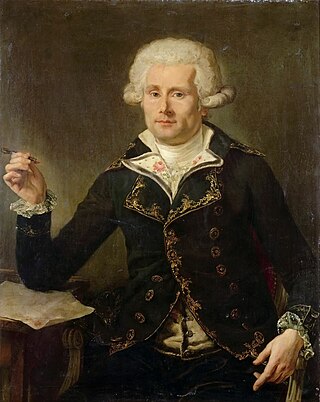
Louis-Antoine, Comte de Bougainville was a French admiral and explorer. A contemporary of the British explorer James Cook, he took part in the Seven Years' War in North America and the American Revolutionary War against Britain. Bougainville later gained fame for his expeditions, including a circumnavigation of the globe in a scientific expedition in 1763, the first recorded settlement on the Falkland Islands, and voyages into the Pacific Ocean. Bougainville Island of Papua New Guinea as well as the Bougainvillea flower are named after him.

Captain Tobias Furneaux was a British navigator and Royal Navy officer, who accompanied James Cook on his second voyage of exploration. He was one of the first men to circumnavigate the world in both directions, and later commanded a British vessel during the American War of Independence.

Samuel Wallis was a British naval officer and explorer of the Pacific Ocean who made the first recorded visit by a European navigator to Tahiti.

Rear-Admiral Philip Carteret, Seigneur of Trinity was a British naval officer and explorer who participated in two of the Royal Navy's circumnavigation expeditions in 1764–66 and 1766–69.
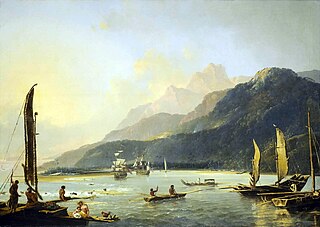
HMS Adventure was a barque that the Royal Navy purchased in 1771. She had been the merchant vessel Marquis of Rockingham, launched in 1770 at Whitby. In naval service she sailed with Resolution on James Cook's second expedition to the Pacific in 1772–1775. She was the first ship to circumnavigate the globe from west to east. After her return she served as a store ship until 1779. The navy sold her in 1783 and she resumed a civilian career, but retaining the name Adventure. She was lost in May 1811.

The Society Islands are an archipelago in the South Pacific Ocean that includes the major islands of Tahiti, Moorea, Raiatea, Bora Bora and Huahine. Politically, they are part of French Polynesia, an overseas country of the French Republic. Geographically, they form part of Polynesia.
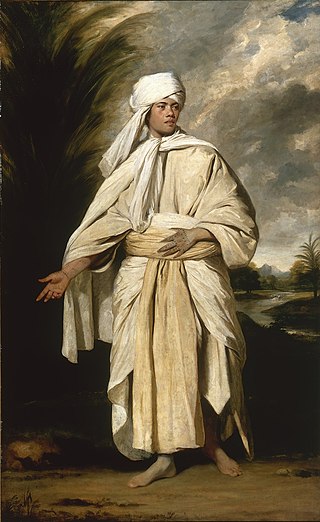
Mai, known as Omai in Britain, was a young Ra'iatean man who became the second Pacific Islander to visit Europe, after Ahutoru who was brought to Paris by Bougainville in 1768.

The first voyage of James Cook was a combined Royal Navy and Royal Society expedition to the south Pacific Ocean aboard HMS Endeavour, from 1768 to 1771. It was the first of three Pacific voyages of which James Cook was the commander. The aims of this first expedition were to observe the 1769 transit of Venus across the Sun, and to seek evidence of the postulated Terra Australis Incognita or "undiscovered southern land".

Boudeuse was a 32-gun, 12-pounder-armed sailing frigate named Boudeuse on 6 June 1765. She is most famous for being the exploration ship of Louis Antoine de Bougainville between 1766 and 1769. She also served in the American and French Revolutionary Wars, during which she captured two enemy vessels. She was broken up for firewood at Malta in early 1800.

Captain John Gore was a British American sailor who circumnavigated the globe four times with the Royal Navy in the 18th century and accompanied Captain James Cook in his discoveries in the Pacific Ocean.

The Tahitians are the indigenous Polynesian people of Tahiti and thirteen other Society Islands in French Polynesia. The numbers may also include the modern population in these islands of mixed Polynesian and French ancestry. Indigenous Tahitians are one of the largest Polynesian ethnic groups, behind the Māori, Samoans and Hawaiians.
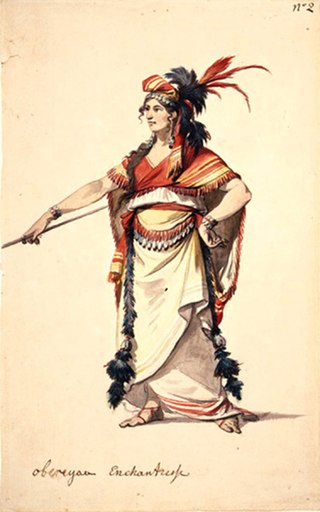
Purea, Tevahine-'ai-roro-atua-i-Ahurai, also called Oborea, was a queen from the Landward Teva tribe and a self-proclaimed ruler of all Tahiti. Queen Purea is known from the first famous European expeditions to Tahiti. She ruled as chieftainess of her tribe area in 1767–1768, when she was encountered by the expedition of Samuel Wallis.

The era of European and American voyages of scientific exploration followed the Age of Discovery and were inspired by a new confidence in science and reason that arose in the Age of Enlightenment. Maritime expeditions in the Age of Discovery were a means of expanding colonial empires, establishing new trade routes and extending diplomatic and trade relations to new territories, but with the Enlightenment scientific curiosity became a new motive for exploration to add to the commercial and political ambitions of the past. See also List of Arctic expeditions and List of Antarctic expeditions.

The second voyage of James Cook, from 1772 to 1775, commissioned by the British government with advice from the Royal Society, was designed to circumnavigate the globe as far south as possible to finally determine whether there was any great southern landmass, or Terra Australis. On his first voyage, Cook had demonstrated by circumnavigating New Zealand that it was not attached to a larger landmass to the south, and he charted almost the entire eastern coastline of Australia, yet Terra Australis was believed to lie further south. Alexander Dalrymple and others of the Royal Society still believed that this massive southern continent should exist. After a delay brought about by the botanist Joseph Banks' unreasonable demands, the ships Resolution and Adventure were fitted for the voyage and set sail for the Antarctic in July 1772.

James Cook's third and final voyage took the route from Plymouth via Tenerife and Cape Town to New Zealand and the Hawaiian Islands, and along the North American coast to the Bering Strait.
Matavai Bay is a bay on the north coast of Tahiti, the largest island in the Windward group of French Polynesia. It is in the commune of Mahina, approximately 8 km east of the capital Pape'ete.

An Account of the Voyages Undertaken by the Order of his Present Majesty for Making Discoveries in the Southern Hemisphere, and successively performed by Commodore Byron, Captain Wallis, Captain Carteret, and Captain Cook, in the Dolphin, the Swallow, and the Endeavour: drawn up from the journals which were kept by the several commanders, and from the papers of Joseph Banks, Esq. is a 1773 book by John Hawkesworth about several Royal Navy voyages to the Pacific: the 1764–1766 and 1766–1768 voyages of HMS Dolphin under John Byron and Samuel Wallis, the voyage of HMS Swallow under Philip Carteret (1766–1769), as well as the 1768–1771 first voyage of James Cook on HMS Endeavour. Hawkesworth received an advance of £6,000 for editing the three volumes.

HMS Swallow was a 14-gun Merlin-class sloop of the Royal Navy. Commissioned in 1745, she initially served in home waters as a convoy escort and cruiser before sailing to join the East Indies Station in 1747. There she served in the squadron of Rear-Admiral Edward Boscawen, taking part in an aborted invasion of Mauritius and the Siege of Pondicherry. In 1755 Swallow returned home to join the Downs Station, as part of which she fought at the Raid on St Malo, Raid on Cherbourg, and Battle of Saint Cast in 1758. She was also present when the French fleet broke out of Brest prior to the Battle of Quiberon Bay in 1759.




















